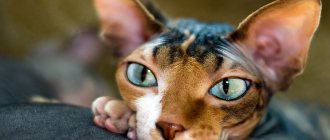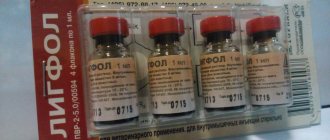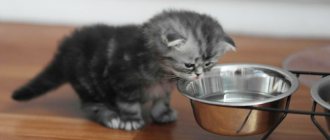Cats are one of the most powerful and agile predators relative to their body size. These animals' senses allow them to lead a full life. Cats rely on their senses of sight, smell, touch and hearing to survive in the wild. Therefore, blindness in cats living in the wild is something of a death sentence. Inevitably, with age, these animals lose visual acuity, giving way to younger individuals. This is how natural selection occurs in the wild.
Of course, old age is not the only cause of blindness.
Unlike cats living on the street, for pets, deterioration of vision or its complete loss is not the end of a full life.
If the cat begins to see poorly, then it will gradually get used to it and adapt to its new position. In turn, the owner must make an effort so that the blind cat quickly adapts and begins to lead a full life again.
Why don't my cat's pupils react to light?
It is generally accepted that cats' main senses are smell and hearing, but healthy eyes are an equally important factor for cat health. It happens that owners notice extremely dilated pupils in their pet, but when the light is turned on, no reaction occurs.
Dilated pupils may indicate a problem.
The following two tabs change content below.
I am a veterinarian in one of the clinics in the city of Gomel (Belarus). I myself am an experienced cat lover, I have two Don Sphynxes. I love these animals very much and they love me back. These are charming cats - Marfa and Petrovna.
There may be many reasons for this, but the most dangerous may be glaucoma, retinal detachment, and hypertensive retinopathy.
Glaucoma
A disease characterized by increased intraocular pressure and an increase in the size of the eyeball. This occurs due to the pressure of fluid on the optic nerves, as a result of which these nerves are damaged, which provokes possible blindness. Basically, the pathology is of secondary origin, primary exposure is a rare case.
Glaucoma occurs when intraocular pressure increases.
Symptoms
The symptoms of glaucoma in the early stages are practically invisible, which significantly complicates subsequent treatment.
Next, clouding appears in both organs of vision. If the lesion is unilateral, a noticeable difference in the size of the eyes gradually becomes noticeable. Strabismus develops, the pupil dilates, stops responding to light, and blindness gradually progresses. As the stage progresses, swelling and protrusion occurs.
Glaucoma causes clouding of the eye.
Treatment
It is impossible to completely cure glaucoma, but you can provide your pet with a fairly comfortable existence.
Pilocarpine is dripped, dorzolamide, thymol
. It is also possible to prescribe steroids, diuretics, vitamins, and painkillers.
Pilocarpine drops are used for treatment.
Retinal detachment
The mechanism of the pathology is the separation of the retina from the fundus of the eye.
This disrupts the blood supply, which interferes with the normal functioning of the retina. One of the reasons is chorioretinitis, a disease caused by infectious peritonitis, leukemia, and arterial hypertension.
Impaired blood supply provokes retinal detachment.
Signs
Clinical signs are not particularly specific, so the basis of diagnosis is differentiation. Main symptoms:
- partial or complete loss of vision;
- lack of reaction to light;
- the presence of floating fragments of the retina and blood vessels;
- accumulation of blood streaks inside the vitreous;
- dilated pupil.
Retinal detachment causes vision loss.
In addition to the symptoms mentioned, it is very important to distinguish the accompanying signs of the disease that caused the detachment.
Treatment
Retinal detachment is characterized by the most acute course due to the fact that the animal goes blind extremely quickly.
Therefore, the effectiveness of the therapy used will depend on the speed of the host’s response.
Prescribed drugs that reduce systemic hypertension, antifungals, glucocorticoids, diuretics
. In most cases, the only remedy is retinopexy.
The surgical method is used for treatment.
Hypertensive retinopathy
A disease that is characterized by damage to the retina and choroid due to chronic processes in the kidneys or hyperthyroidism.
Provoking factors for the development of primary ailments are violations of the conditions of keeping pets - routine medical examinations, unsanitary conditions.
Cats living in unsanitary conditions are at risk.
Signs
Signs of hypertensive type retinopathy are expressed in a gradual decrease in vision, which subsequently leads to complete blindness.
The pupils are maximally dilated and there is no reaction to light. Bloody veins are visible inside the eyes. Blood pressure is increased, weakness, apathy, and loss of coordination of movements occur.
There may be a urge to vomit.
Therapeutic measures
are based on eliminating the primary factor. At the same time, symptomatic treatment is carried out - painkillers, elimination of fluid deficiency. Removal of intoxication, ophthalmic local remedies.
Causes of vision loss
Slow
Cat's eyes have a complex structure, so if the structure of the organ is damaged for some reason, the eye loses its functionality, which, if not treated in a timely manner, inevitably leads to a partial or complete loss of the ability to see.
With some types of diseases, the animal becomes blind slowly, gradually getting used to and adapting to this condition. Gradual blindness in a pet can develop against the background of such dangerous pathologies:
- Malignant neoplasms in the eye or brain tissue. With this disease, the eyeball may increase in size or move to the side. In addition, the cat has other pathological symptoms: disorientation in space, weakness, drowsiness, weight loss.
- Glaucoma. This is a dangerous pathology in which the animal’s intracranial pressure increases. The cat suffers from chronic headaches and is constantly irritated. As the disease progresses, the field of vision narrows significantly; if the disease is not identified and treated in a timely manner, the animal becomes completely blind.
- Cataract. With this disease, clouding of the lens is observed. Cataracts often develop against the background of diabetes mellitus and helminthic infestation, in particular, when infected with chlamydia.
- Elderly age. An old cat, even if he lives in good conditions, with age ceases to clearly and clearly see objects located in the house. The cat's pupil stops reacting normally to a light stimulus, and the field of vision narrows.
Poor nutrition and vitamin deficiency in a pet can lead to gradual loss of vision.
Other reasons:
- poor nutrition;
- avitaminosis;
- inflammatory diseases of the cornea;
- congenital anomalies of the development of organs of the visual system.
Sudden loss
If a cat suddenly becomes blind in one or both eyes, it is first of all important to rule out injury to the organ of vision, as well as a concussion. Optic neuritis, which is inflammation of the optic nerve, can also negatively affect an animal's ability to see normally. At the initial stage, the signs are not pronounced, but as it progresses, the animal can no longer live a full life because it does not see as well as before.
Another cause of sudden loss of visual function is arterial hypertension. If blood pressure rises sharply, small vessels in the cat's eye become damaged. Excessive hemorrhages appear in the area of the iris or on the whites, which often leads to retinal detachment and a sharp loss of the ability to see the outside world. Other characteristic signs of hypertension: mydriasis, corneal edema, lacrimation, nausea and vomiting.
It is rare, but it still happens that an eyeless kitten is born, which, due to a congenital anomaly in the development of the visual system, is completely missing eyes. Blind kittens, in addition to the fact that they do not see anything, are no different in growth and development from their sighted relatives. There are cases where a blind pet had free access to the street and successfully hunted using only hearing and smell.
Orientation in space
When the man brought the cat from the clinic, where Jim spent 3 months in a one and a half meter box, and released him from the carrier, he simply remained lying where he was left. The animal is unaccustomed to space. The owner decided to let the pet know that there was a lot of space around. The owner raised his hand to the pet, touched it, and then removed it. Jim reached for her and walked away. At first he followed the young man's feet. The owner took a couple of steps, Jim caught up and poked his muzzle into the leg. All this time the young man did not stop talking to him.
Video about vision in cats
The cat is one of the most dexterous and powerful predators, relative to body size. Felines, like people, use 4 tools for orientation in space: smell, hearing, vision and touch. Blindness in cats in the wild is a death sentence with no right of appeal. As an animal ages, it loses its visual acuity; this is one of the tools of natural selection; older individuals “give way” to younger ones. The lifespan of domesticated pets reaches 10–15, sometimes 20 years, which means degenerative changes are inevitable. However, vision loss can be associated not only with advanced age.
There is a generally accepted but unproven belief that four-legged animals see the world in black and white. Experiments conducted to confirm monochromatic vision have not given clear results; it is believed that cats can distinguish shades of blue, green and red. The structure of the “striped” eyeball is very similar to that of humans; before the “picture” reaches the brain, the spectrum of light rays passes through:
- The cornea
is the visible surface of the eye, which is covered with mucous membrane.
- The eye chamber
is the space bounded by the cornea and iris. The chamber is filled with a transparent liquid, performs a protective function, and allows you to restrain inflammatory processes.
- The pupil
is located on the iris. Depending on the brightness of the lighting, the pupils reflexively narrow or dilate (accommodation). The central nervous system is responsible for its correct functioning.
- The lens
is the part of the eyeball responsible for refraction and separation of light rays into a spectrum. It has a transparent structure and the shape of a round lens, convex on both sides.
- The vitreous
is a thick, jelly-like clear fluid that fills the cavity between the lens and the retina.
- Retina (photosensitive membrane)
- consists of receptor cells, rods and cones, which convert the received information into a nerve impulse.
- The optic nerve
is a pair of nerve endings that transmit the converted impulse from the retina to the brain.
Causes of blindness in cats.
Blindness can be caused by many reasons. Some causes lead to gradual, slow deterioration of vision, and in these cases, cats are often able to adapt surprisingly well to the visual impairment, showing little or no signs that they are experiencing any difficulties. However, if blindness develops quickly, the cat does not have time to adapt and experiences significant difficulties in orientation. Among the causes of sudden blindness are the following:
Optic neuritis.
In this condition, the optic nerves (nerves that transmit visual information to the brain) become inflamed and, as a result, no longer function, leading to blindness. This disease is very rare in cats.
Hypertension (high blood pressure).
Hypertension
- a common disease, one of the main causes of sudden development of blindness in cats. High blood pressure can damage the small blood vessels at the back of the eye, causing the blood vessels to bleed, or leak fluid. This in turn can lead to a detachment of the retina (the layer of light-sensitive cells that are located at the back of the eye and allow us to see). Having detached, the retina can no longer perform its functions, causing the cat to go blind. In some cats, high blood pressure can cause some bleeding towards the front of the eye, which can be easily noticed.
Brain diseases.
Because visual signals are transmitted through the optic nerves to the brain, which processes them, brain problems (caused by infection, inflammation or tumors) can potentially lead to blindness in a cat.
Retinal degeneration.
Like humans, cats can suffer from degeneration of the layer of light-sensitive cells at the back of the eye (retina), which is responsible for vision.
Symptoms
- Clumsiness
- Collision with objects
- Inability to find food and water
- Inattention, excessive sleepiness
- Nervousness and irritability
- Loss of interest in games
- Loss in the surrounding space
When your cat experiences vision loss and you, not knowing what to do, are looking for advice on this topic on the Internet on forums, we recommend not to self-medicate or experiment on your beloved cat. The fact is that there are many causes of blindness in an animal, and the consequences of your experiment may disappoint you and your family.
Description of the pathology
The cat's eye is a precise, complex and fragile instrument. Damage to any of its structural components can cause vision loss.
In medical and veterinary practice it is customary to distinguish:
- amaurosis or absolute loss of vision;
- scotoma or partial loss of visual fields;
- hemianopsia - loss of half the visual field.
Blindness can be acquired or congenital. The animal may become blind in one eye or both. There are many reasons for the development of this pathology. Moreover, if some of them are eliminated, the animal’s vision can be partially or completely restored. But there may be cases when damage to the organ of vision is irreversible and the animal remains blind for the rest of its life.
How to find out if a cat can see?
Given the high adaptability of cats, problems with vision, which is lost gradually, can be identified at fairly advanced stages. The pet becomes less mobile, sleeps more, prefers to move exclusively on floor surfaces, which does not cause much concern for the owners. Blindness in a cat can be determined by a number of the following signs:
- Refusal to jump.
- Careful movement around the home.
- It is difficult for a cat to control the sequence of steps; while walking, the animal stumbles into an amble and stops.
- A large number of broken whiskers are observed. With complete or partial loss of vision, the cat “feels the world” and picks up air vibrations with its whiskers.
- There is no reflection of the eyes in the dark, but in the light, the gaze is deconcentrated.
- The animal crashes into objects that are not in their “usual” place.
The characteristics of the cat's central nervous system explain a number of nuances that can be mistaken for vision loss if the pet cannot see.
So, you are planning to buy a disabled cat or have already purchased one. If this is your thoughtful decision, my applause! Know that you really helped a living being. Disabled animals have the least chance of finding their home. If you acquired such a cat by mistake or by accident, then I beg you: do not throw it out onto the street! In outdoor conditions (among violent people, packs of dogs and crazy traffic), the likelihood that a blind or deaf animal will survive is minimal.
Of course, caring for a blind cat will be unique, but still not particularly difficult. The behavior of a blind animal will also differ from that of a healthy cat. I will talk about this below.
What diseases can cause a cat to go blind? Eye injuries, congenital defects, conjunctival diseases, tumors, glaucoma, cataracts, hyperthyroidism, dry eye syndrome.
A cat has been diagnosed with blindness: is there a chance of regaining vision?
Help her with this!
Gwen Cooper's book “Homer's Odyssey” tells the true story of a blind kitten who not only lives a full life as a cat (moves freely around the house, makes friends with two other cats and catches flies better than them), but also becomes a real superhero. So, he stopped a burglar who broke into the house, inspired her to write a book and helped the owner meet the man of her dreams. — Recommended reading!
Especially for 33cats.ru, Maxim Naumov
Pictured is Gwen Cooper with her cat Homer
20.02.2013
Care and maintenance
If you notice that your pet is having vision problems, contact your veterinarian as soon as possible. Place the cat in a safe and quiet place until the cause of the vision loss is determined. Limit your pet's access to the pool, stairs, balconies and hot water. Don't leave your cat unattended.
Place food and water not far from the animal so that he can easily find them; if necessary, help him; you can use a leash for this.
Do not allow your cat to scratch its eyes, as this may cause injury or infection. If necessary, use an Elizabethan collar.
Cat breed
: Persian Asks
: Svetlana Antropova.
The essence of the question
: The cat’s pupils are dilated over the entire eye, what should I do?
The cat's pupils are dilated over the entire eye. Doesn't respond to light. He doesn't eat well. I am very worried.
How does a blind cat behave?
Here it is important to clarify whether the cat was initially blind or whether it became blind instantly. If a cat is born blind, she will not realize that she is missing an important bodily function. Her behavior is closest to the behavior of a healthy cat. If blindness occurs quickly, the cat experiences enormous stress, shows anxiety and fear, and can become aggressive. Such an animal should be given special attention and care. A blind cat can become more affectionate, because now the owner has become its reference point. Blind cats initially climb rather than jump to high places; This is how they remember the height of an object. However, later they can also jump, for example, onto a cabinet, like healthy cats. If your cat is lying on a cabinet or cabinet, check to see if there is any unexpected obstruction underneath. A cat that is blind in one eye may show aggression in response to sudden movements. Such cats study an object for a long time before jumping on it or approaching it, since they have lost their stereoscopic vision area.
Caring for a blind cat.
Even if the blindness has become permanent, cats usually adapt very well to vision loss. They perfectly compensate for vision with other senses - hearing, smell and touch (using vibrissae to prevent collisions with objects). However, sudden loss of vision is very stressful for cats. They may bump into objects in the house, or hide in places where they feel safe.
In order for a blind cat to feel normal, certain changes will have to be made that will make their life easier. Furniture and resources (food, water, bedding, trays) should be in the same, easily accessible place. Care should be taken to avoid noisy activities, children should be taught to move carefully so as not to frighten the cat, who cannot see them.
Blind cats should live indoors, going only to closed areas where they cannot get lost or be attacked by other animals. After some time, living in a constant environment, most blind cats adapt well and live quite happily.
Signs of blindness
A cat's blind eye is often covered with a veil, or the pupil remains dilated even in bright light.
The animal will not be able to say that it sees poorly. However, a person can determine by certain signs that a cat has lost its sight:
- the animal stops moving a lot and spends more time dozing;
- walks only on the floor, jumps less or not at all;
- walks around the house carefully;
- The blind cat's whiskers are broken off. This is due to the fact that the whiskers are the main sensory organ of a blind cat. With them she feels the world, catches vibrations in the air;
- eyes do not glow in the dark;
- while moving, it crashes into objects that are not located in their usual places.
A cat that is blind in one eye may lash out in self-defense if you make sudden movements on its blind side.
Videos and Illustrations
Cloudy eyes in cats. Veterinary clinic Bio-Vet
Glaucoma
Keratitis
Uveitis
The blind eye does not glow when hit by light
How should you care for a blind cat?
- Try not to rearrange the furniture or your cat's litter box or bowl. Blind cats rely heavily on memory.
- In a new place (if you have moved), do not leave the blind cat, watch how it explores the new place. Help her find the toilet and tray.
- Eliminate objects that are dangerous for the cat: fireplace, sharp objects, access to the balcony, open windows.
- Don't leave your cat alone outside! If she is used to walking, take her out on a leash.
- If there is a chance that the cat will be alone on the street, purchase a collar on which you indicate not only your phone number, but also the fact that the cat is blind.
- If you have other pets, you can provide them with collars with bells or some kind of jingling decorations so that the blind cat knows about their approach and is guided by the sound.
- Try to avoid sudden loud sounds. If a sound frightens your cat, calm it down.
- Talk to your cat more, sing. This will let your cat know about your movements around the house and will calm her down. You should talk to a blind cat quietly and softly. Make a voice when entering the cat's room, intending to touch it or sit next to it: from surprise, it may scratch or bite you.
- Play with your blind cat using clinking or rustling toys. Blind cats are just as active as healthy ones; do not deprive your pet of the pleasure of playing and communicating with you. If the cat is not yet accustomed to blindness, such a toy will help it focus on sound.
- Try to pick up your pet less often: this will disorient the cat. If you do pick up the cat, you should lower it to a place that is well known to the cat, preferably not on a hill.
- The easiest way for a blind cat to fall is from a balcony or window. Don't forget about it!
- It is useful to teach a blind cat a command that will cause it to stop immediately. For example, “Stop” or “No”.
- Remember that blind cats rely on familiar sounds and smells. If your cat gets lost on the street, he will never find his way back. Follow these rules and your blind cat will live a long, happy life. A blind cat that has settled into the house is active, cheerful and energetic, he rushes along the corridor after a jingling toy and easily jumps onto a tall cabinet. At times, you yourself will forget that your cat cannot see. Healthy or disabled, this is your cat with his own character and habits, special and unique. Remember this!
Cats are one of the most powerful and agile predators relative to their body size. These animals' senses allow them to lead a full life. Cats rely on their senses of sight, smell, touch and hearing to survive in the wild. Therefore, blindness in cats living in the wild is something of a death sentence. Inevitably, with age, these animals lose visual acuity, giving way to younger individuals. This is how natural selection occurs in the wild.
Of course, old age is not the only cause of blindness.
Unlike cats living on the street, for pets, deterioration of vision or its complete loss is not the end of a full life.
If the cat begins to see poorly, then it will gradually get used to it and adapt to its new position. In turn, the owner must make an effort so that the blind cat quickly adapts and begins to lead a full life again.
Cats can lose their vision for a variety of reasons, and although in most cases it weakens with age, a kitten can also go blind. Visually impaired cats adapt well, especially if we help them.
There are a number of diseases that can lead to vision loss, even loss. The first thing that comes to mind for owners is various eye injuries.
From the point of view of specialists, an important role is played by diseases of the conjunctiva of an allergic or infectious nature (including neonatal conjunctivitis), eye infection caused by the herpes virus, tumors, of which the ophthalmologist especially notes retinal melanoma.
Conditions such as glaucoma (increased intraocular pressure) and cataracts (clouding of the lens, preventing light from reaching the retina) affect cats just as they do humans. A general increase in blood pressure can also have a detrimental effect on vision (hypertension can be a consequence of diabetes, kidney disease, hormonal disorders and other general diseases).
Of the hereditary disorders, the first thing to remember is progressive retinal atrophy, an incurable disease that gradually leads to complete loss of vision. It progresses gradually and painlessly, so no significant changes in the cat’s behavior are observed. In general, a cat adapts to vision loss much more easily than a person for completely natural reasons.
The cat is known to be a predator, preying on small rodents in low light conditions. So bad that, according to human estimates, nothing is visible. But a cat's eye sees in the dark 6 times better than ours.
Hearing, smell and touch are also very important; the night hunter uses them for orientation in space to a much greater extent than animals active during daylight hours. This explains the greater ease of adaptation to vision loss - those organs and analyzers that must take on its work are already sufficiently trained.
Over time, a blind cat’s hearing and sense of smell become even more acute, and its “whiskers” (vibrissae) increase by 30%. If vision loss occurs gradually, then in a familiar environment the cat can navigate no worse than a sighted cat. Owners notice something is wrong after repairs or rearrangements, when their pet suddenly starts bumping into everything.
But in the case when blindness occurs abruptly, suddenly, the owner is simply obliged to notice changes in the animal’s behavior. The cat walks, bumping into furniture, does not immediately find a bowl and tray; If only one eye is affected, sudden and unexpected movements from the affected side frighten the animal. When keeping a blind cat in the house, certain rules must be followed:
Unchangeable situation.
A cat that has lost its sight relies very heavily on its memory, on its familiar “map of the area.” Changing the arrangement of objects in a house where cats with poor eyesight live is strictly not recommended. The bed, bowls, toilet, scratching post, and toys should be in their usual places.
When rearrangements cannot be avoided, show your cat the way to the new place more than once or twice. If the room is unfamiliar (moving to a new apartment, for example), you need to patiently accustom the cat to each place, placing it next to it (directly in the tray - in the case of a tray) and allowing the cat to find its way from these most significant objects to others parts of her possessions.
Safe environment.
Blind cats should not be allowed near dangerous places, and they should be retrained to go down stairs. It is very easy for a disorientated animal to fall from a staircase or balcony. Approaches to the fireplace, exits to the balcony, and staircase must be blocked. Remove all sharp objects and wrap something soft around dangerous corners. There should be nothing unnecessary on the floor - now this is not only a matter of order, but also of convenient movement of the cat around the house.
No lonely walks.
A blind cat should not walk on its own! Only with the owner and on a leash. Train your cat to wear a harness. In addition, securely attach a tag with your phone number and information that the cat is blind to the harness or collar (the collar is not for attaching a leash!). Blindness will not prevent her, when frightened, from rushing in an unknown direction, and it is unlikely that you will be able to catch her, so make sure you are as safe as possible.
If a cat lives in a country cottage, then it is better for her to have a well-fenced and landscaped enclosure on the property. You can only let your cat free-range in an area where the cat is familiar with everything if you are 100% sure that the fences are cat-proof and that you have removed or securely covered all dangerous objects, pits, pools and other potential hazards. Still, it’s better not to leave your cat alone outside.
In cats that have lost their vision, other senses become more acute: smell and hearing. This is a natural compensatory reaction and should be used to help your cat navigate the house. For example, you can “mark” rooms with different subtle scents so that your cat always knows where he is.
Strong and unpleasant odors should be avoided! Also try to avoid loud, frightening sounds, and if this still fails, for example, something fell with a crash, find the cat and pet it so that it calms down.
Talk to the cat!
This gives her a feeling of security and calms her down. She hears that someone has entered the room - say something to her, let her know that it is you! Talk to her before petting or picking her up, otherwise she may get scared out of surprise, not accept affection, and even bite or scratch. A blind cat can become a “Velcro” cat - constantly following its owner, using him as a guide. In this case, inform your cat when you leave the room, making the task easier.
A blind cat may also rely on other cats to navigate around the house. If there are several animals in the house, you can put collars with bells on them to warn the cat of their approach with a characteristic sound.
Games are required.
Blind cats lead a less active lifestyle and actively gain weight. To maintain physical fitness, play with them more. Cats begin to navigate by sounds; they like rustling, mouse-like squeaking, buzzing toys, bells, and rattles.
Blind cat playing with toys
Live and rejoice
In Gwen Cooper's book "Homer's Odyssey"
tells the true story of a blind kitten who moves freely around the house, makes friends with two other cats, catches flies better than them, and generally lives a full life as a cat. Here's how Gwen writes about him:
"What a pity!" - I often hear when people learn that Homer lost his sight at the age of two months. To which I immediately respond: “Show me a more cheerful cat, and I’m only for watching!” “I’ll give you a hundred dollars right away.” No one has yet encroached on this amount.
“Yes, but how does he... uh... get out of the situation?” - usually follows a question. “On my own four,” I answer, “like any other healthy cat.”
It happens, however, that if Homer gets too excited, I hear a dull thud - a bale! This means that his head hit the wall or the leg of a chair, which he forgot about in the heat of the game. Now this sound makes me smile, although my heart skips a beat out of habit. But who among you could resist smiling at the sight of your cat, having played out, plopping off the sofa, pulling the blanket behind him, or at the way he stunnedly examines the glass door that he was eager to meet in pursuit of an invisible goal? PAN KAZIMIR
Nine-year-old Kazimir
(to relatives and friends simply Kuzya) is the child of Siberian-Persian love. He has a rare chinchilla color and an equally rare ideal disposition.
“The only cat that never gave me a scratch. Even as a child, when playing, he did not let go of his claws,” says Kazimir’s owner. — At the same time, you can’t call it “Velcro” either. He is unobtrusive and does not seek to take a place on your lap. Self-sufficient cat. Casimir always treated other animals kindly, one might say patronizingly, but again he did not suffer from excessive sociability.
Although, when a small cat appeared in the house, he certainly turned into a voluntary nanny.” Let’s say right away: no misadventures could spoil Kazimir’s character.
And they started four years ago - with one unhappy walk. Since Kazimir’s house is located in a place that fully corresponds to the description “quiet and green,” no one blocked the cats’ access to the street.
And the neighbor’s call: “Kuzya is hobbling home, come out to meet him, otherwise he won’t reach the door,” sounded like a bolt from the blue. The veterinary clinic diagnosed a concussion and deformation of the eyeball and said that a person had contributed to this using a stick or stone...
The damaged eye was removed. Left with one eye, Kazimir first settled on the terrace and looked out the window. It is clear that from that moment no one allowed him outside. At home he behaved as usual, except that he looked around, turning his entire head and, if he heard some sound from the direction of his missing eye, he jumped back slightly.
And everything would have been fine, but four years later problems began with the remaining eye. This spring, conservative treatment could no longer contain the pathological process, and the second eye also had to be removed. Complete blindness set in, but by this time the cat already had familiar, well-mastered routes for moving around the house.
Still, the vision in the last eye gradually decreased, and he most likely stopped seeing even before the operation. But in the cat team, or rather, on its hierarchical ladder, some rearrangements could not be avoided.
However, these changes are inevitable when the second male grows up. The younger cat (who appeared shortly after the removal of Kazimir’s first eye), having reached puberty, began periodically swinging at his older comrade near bowls and rookeries.
But this is so, just raise your paw, at the very least a light slap in the face. There were no fights or other bloodshed (perhaps because everyone is now castrated). The fair half of the pride is absolutely indifferent to male squabbles. Kuzya’s daughter dotes on him, and the cat Lisa simply proudly ignores everyone (as always). BLIND MUSICIAN
Six-year-old blind cat
Stevie Wonder
, named after the famous American singer and composer, loves to press the piano keys. He exercises every day in the house of one of the employees of the Greenwood shelter for homeless animals (Cambridgeshire, UK). And the shelter staff, while looking for Stevie’s permanent homes, enjoy attending his concerts.
Blind Cat Rescue
This shelter in North Carolina (USA) was created in 2005 to provide shelter to cats whose vision was assessed as 20% or less of normal, which was why they were not accepted into regular shelters.
“Blind cats are animals that simply cannot see. They have no idea that they are blind. They know they are cats. They act like cats, says the Blind Cat Rescue manifesto. “Blind cats can do almost everything that a seeing cat can do.”
Ekaterina SAVITSKAYA
Forum KOTODOM
Many cat owners do not even suspect that their proud pet is gradually losing his sight. Blindness in cats can be reversible or irreversible, partial or complete. What can cause blindness in cats?
1. Cataract. Cats can also develop cataracts. This is a condition in which the lens of the eye becomes cloudy. Cataracts usually develop due to eye injury, diabetes, or a genetic problem. Cataracts are treated surgically.
2. Glaucoma. A tumor, injury or any other hereditary disease can lead to excess pressure in the eyes, which can result in glaucoma. This is a common cause of blindness in cats. Glaucoma is treated by lowering intraocular pressure.
3. Tumors. Tumors of the eye often lead to blindness. In many cases, the eye has to be removed surgically.
4. Progressive retinal atrophy. This is an incurable disease and is most likely hereditary. This is a very slowly developing disease, under the influence of which the cat gradually completely loses vision. Because the disease progresses slowly, cats learn to cope with the gradual loss of vision and can live with vision loss.
5. Hypertension. Cats with kidney disease and diabetes are predisposed to hypertension. Hypertension can contribute to retinal detachment due to an overactive thyroid gland or kidney disease. There is no specific treatment for hypertension, but the cat should be kept on a salt-free diet.
6. Conjunctivitis. This infection causes the inner eyelid to become red, swollen and itchy. Although conjunctivitis does not cause complete blindness, repeated infection can cause blurred vision. Treatment may be in the form of eye drops or oral medications depending on the cause of the infection. There are other causes of blindness in cats, including: trauma, retinal degeneration, neoplasia, hypoxia, congenital underdevelopment of the optic nerves, and encephalitis. It is very important to make a correct diagnosis, since treatment will be determined by the diagnosis. In many cases, blindness is the result of hidden disorders or diseases that have a significant impact on the cat's health. Sudden blindness in cats is usually provoked by hypertension, thyroid disease, and kidney disease.
Signs of blindness in cats: 1. The cat constantly bumps into objects. 2. The cat has poor control over the coordination of paw movements. 3. Cloudiness of the eye or dilation of the pupil even in bright light. 4. Noticeable clumsiness of the cat. 5. The cat cannot find a cup of food or water. 6. The cat sleeps a lot and is inattentive. 7. The cat gets scared easily and seems timid. 8. The cat refuses to play and does not hunt.
Caring for a blind cat, of course, falls entirely on the owner. The first thing to do is take your cat to the vet as soon as you suspect vision problems. If your cat partially or completely loses its vision, do not abandon the poor animal under any circumstances. After all, this is cruel. Treat her the same way you would treat a blind person. A blind cat is quite adaptable and uses other senses to compensate for the loss of vision. Make sure your cat doesn't wander outside alone for long periods of time. Let your cat outside only under supervision. You can put a collar and leash on your cat and take her for a walk on a leash. Label the collar with your name and address in case your cat gets lost. A blind cat can walk around the house on its own. Cats have scent glands on their paws that leave a trail that cats can easily follow. You should not carry your cat around the house in your arms. Let your cat be independent. Limit your cat's movement near hot water, balconies, and stairs, as an accident may occur with a blind cat near these dangerous places. When approaching the cat, talk to it so that it does not get scared. If the cat is blind in one eye, approach it from the side of the sighted eye. Do not move furniture, tray, or cup of food unless absolutely necessary. Unexpected changes can disorient a blind cat. When playing with your cat, use toys that make sounds, this will help your cat maintain physical fitness and enjoy life.
Blindness can cause a feeling of helplessness in both the animal and the owner. But cats have a strong will and quickly adapt to this condition. This requires support, attention and care from the owner. A blind cat is still your cat and should be cared for like a healthy cat.
CONSULT YOUR VETERINARIAN
Cats can lose their vision for a variety of reasons. Vision often weakens with age, but due to injury or disease, even a kitten can go blind. What to do if your cat is blind? How to help?
Firstly, you need to take a healthy approach to the situation. You should not try on the loss of vision on yourself and transfer the terrible human experiences about this to your cat. Cats themselves are unlikely to be prone to getting emotional and causing tragedy; Blind domestic cats can lead normal lives and feel happy. A blind cat needs help, but not pity.
Secondly, you should definitely consult a good veterinarian. The doctor will be able to correctly diagnose, prescribe the necessary treatment and recommend special care for a blind cat. What if, under certain conditions, vision can be restored? Or maybe the loss of vision is partial, and proper care will prevent complete blindness? In any case, a blind cat should be regularly shown to a veterinarian to monitor its eyes and general health.
Thirdly, it depends mainly on the owners themselves how comfortable and fulfilling their pet’s life will be day after day.
Diagnostics of visual function
A pet showing signs of low vision should be seen by a veterinary ophthalmologist. Visual inspection is carried out using special optical instruments with magnification and lighting functions. Such diagnostics will allow:
More complex methods - video ophthalmoscopy and electroretinography - will make it possible to diagnose the condition of the retina and identify degenerative processes occurring in it. Using tonometry, glaucoma is detected or excluded.
An ultrasound of the eyeball is prescribed to determine the position of the lens, a detailed examination of the retina, and detect tumors in the vitreous body. Sometimes, to obtain a picture of brain tissue and identify inflammatory processes in the internal structures of the eye, MRI is used.
Biochemical and laboratory tests of blood and urine complete the clinical picture. On their basis, chronic internal diseases such as renal failure, diabetes mellitus and other pathologies associated with blindness are diagnosed.
Such a companion will follow the person always and everywhere, like a devoted dog. A blind pet's excellent hearing will allow it to instantly respond to its owner's voice. A blind animal will not refuse toys equipped with sound signals.
Diagnosis of sudden blindness in cats.
The first step is for the veterinarian to verify that the cause of the clinical signs exhibited by the cat is blindness. To do this, as a rule, it is enough to carry out a few simple tests.
Once blindness is confirmed, further testing is required to identify possible causes.
- Careful eye examination - Many causes of blindness can be detected by simply examining the eyes with an ophthalmoscope (an instrument used by doctors to examine the internal structures of the eye).
- Blood pressure measurement - performed because one of the common causes of blindness in cats is hypertension. This is easier than it sounds and is usually done, as in humans, with a special cuff wrapped around the paw. Pressure is measured by inflating and deflating the cuff.
- Urine and blood tests - usually done to detect underlying medical conditions. For example, chronic kidney failure often causes high blood pressure in cats. Brain scans – In some cases, especially when brain disease is suspected, veterinarians will order an MRI or CT scan. Such procedures are carried out in specialized clinics.











